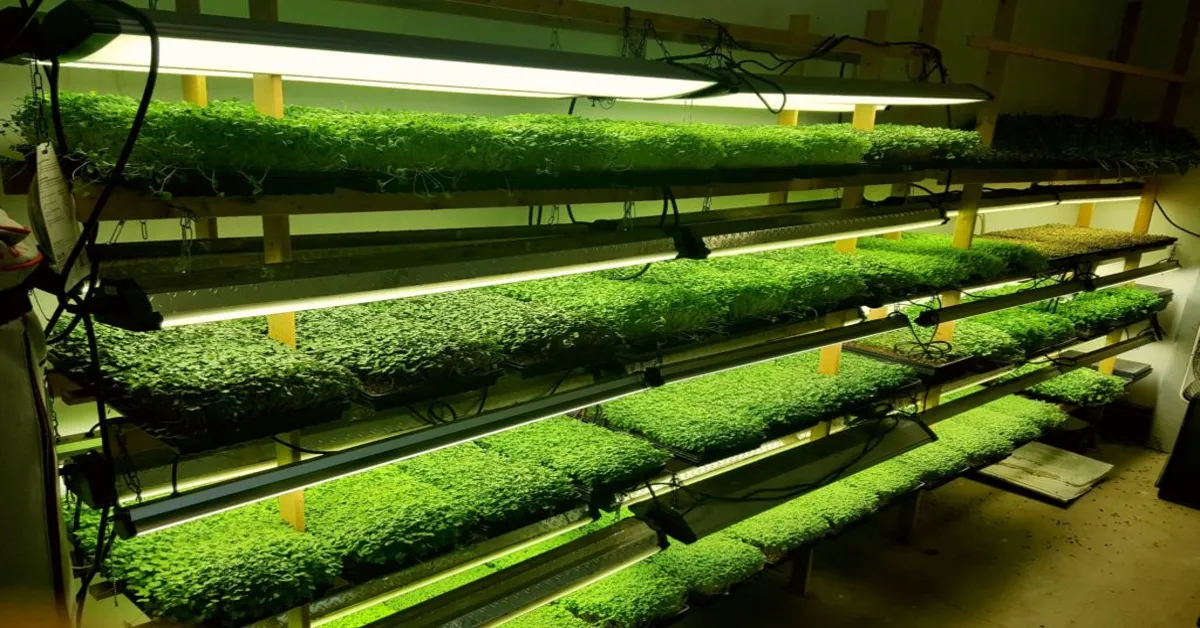**The green revolution is here, and it’s smaller than you think.** Meet the microgreens – these tiny, nutritious sprouts are shaking up the world of agriculture, and they’re doing it from the comfort of home. Aspiring entrepreneurs and green thumbs alike are turning their passion for these petite plants into lucrative enterprises.
Our guide will navigate you through the intricacies of a **microgreens farming business plan**, helping you cultivate not only your dream garden but also a thriving business. Let’s dive into the world of seeds, soil, and sustainability, where every microgreen is a micro goldmine.
Introduction to Microgreens Farming
Embarking on a Microgreens Farming Business Plan Starting a microgreens farming business requires a comprehensive and well-thought-out plan. This is not just a garden-variety business, but a venture that taps into the booming market for healthy, organic produce. The business plan should encompass several critical aspects like the choice of microgreens, the farming method, market analysis, marketing strategy, and financial projections.
Choosing the Microgreens The first step in our microgreens farming business plan is choosing the right kind of microgreens. These could range from arugula to radish, broccoli, cilantro, and many more. The choice depends on factors like growth rate, yield, and market demand.
Farming Method The microgreens farming business plan should also detail the farming method. Whether it’s soil-based or hydroponic, the method must be efficient, scalable, and sustainable. Market Analysis Understanding the market is crucial in our microgreens farming business plan.
It involves studying the demand for microgreens, identifying potential customers, and analyzing the competition. Marketing Strategy The business plan should also include a robust marketing strategy, outlining how to reach potential customers and position the brand in the microgreens market. Financial Projections Lastly, the microgreens farming business plan must provide realistic financial projections, giving an idea of the potential profitability of the venture.
This includes estimates of startup costs, operational costs, revenue, and profit margins. In conclusion, a comprehensive microgreens farming business plan is the roadmap to success in this lucrative but competitive field.

Understanding the Market
Starting a Microgreens Farming Business Embarking on a microgreens farming business is an exciting venture that promises not only a profitable return on investment but also contributes to sustainability. This business plan outlines the necessary steps and considerations essential in establishing a successful microgreens farming business. Market Analysis Understanding your market is crucial in any business plan.
Assess the current demand for microgreens in your locale, identify your potential customers, and study your competitors. Production Plan Your microgreens farming business plan should include a detailed production plan. It should cover everything from selecting the right seeds, setting up the growing area, to harvesting and packaging.
Marketing and Sales Strategy Crafting a marketing and sales strategy is significant for your microgreens business. Utilize both traditional and digital marketing methods to reach a wider audience. Financial Projections The financial aspect of your business plan should provide a clear forecast of revenue, expenses, and profit margins.
Conclusion In conclusion, a microgreens farming business plan is a comprehensive blueprint that guides you in setting up and managing your business. It ensures you are prepared for potential challenges, and sets you on the path to profitability and sustainability.
Starting your Microgreens Farming Business
Microgreens Farming Business Plan: A Glimpse into the Future of Agriculture. Microgreens have gained significant popularity in the realm of health and nutrition due to their rich nutrient content and versatility. Starting a microgreens farming business can be a lucrative venture, given the rising demand for these tiny, yet potent, greens.
However, like any other business, it requires a well-thought-out plan to ensure sustainable success. Understanding the Market: The first step in crafting a microgreens farming business plan involves understanding the market for microgreens. This includes identifying potential customers, analyzing competitors, and determining the unique selling proposition for your microgreens.
Setting Up the Farm: Microgreens can be grown indoors or outdoors, depending on the available resources and climate conditions. The setup process includes procuring the necessary equipment, selecting the suitable microgreen varieties, and establishing a conducive growing environment. Marketing and Sales Strategy: The success of the microgreens farming business highly depends on effective marketing and sales strategies.
This could involve leveraging digital platforms, collaborating with local restaurants and supermarkets, and participating in farmers’ markets. Financing and Budgeting: This aspect of the business plan involves identifying potential sources of funding, estimating the startup costs, and planning the budget for various operational expenses. Legal and Regulatory Compliance: To ensure the smooth operation of the business, it is crucial to understand and comply with the relevant legal and regulatory requirements.
A well-designed microgreens farming business plan can pave the way for a profitable and sustainable business venture. It can provide a roadmap to navigate the complexities of the business and help in making informed decisions.
Investment and Profitability
Embarking on a Microgreens Farming Business Plan Starting a microgreens farming business requires a comprehensive plan that will guide you to success. This plan should detail important elements like market research, financial projections, and marketing strategies. By addressing each aspect thoroughly, you can ensure that your venture into microgreens farming will be well-structured and profitable.
Your microgreens farming business plan should start with identifying your target market. Research on consumer behavior, preferences, and purchasing power will be beneficial in crafting a plan tailored to your potential customers. Once you’ve identified your target market, you can move on to financial projections.
This involves determining your initial costs, ongoing expenses, and potential revenue sources. With these figures at hand, you can then devise strategies to reach your financial goals. Next, your marketing strategies should be outlined in your microgreens farming business plan.
This involves identifying effective promotional channels and creating compelling marketing content. With a well-crafted marketing strategy, you can attract a steady stream of customers and ensure the sustainability of your microgreens farming business. In conclusion, a microgreens farming business plan is an essential tool in launching a successful venture.
By paying attention to market research, financial projections, and marketing strategies, you can create a business plan that will steer you towards profitability.
Business Operations
Microgreens Farming Business Plan – A Green Venture Worth Pursuing Starting a microgreens farming business can be a lucrative and eco-friendly venture. Microgreens, the young seedlings of vegetables and herbs, offer not just culinary benefits but also promise substantial profit margins. The business plan for this venture encompasses several aspects, including identifying the right market, choosing the appropriate microgreen varieties, investing in necessary equipment, and adopting effective marketing strategies.
Leveraging cutting-edge technology and sustainable farming practices can further enhance the profitability of your microgreens farming business. With a well-crafted business plan, your microgreens farm can stand tall amidst competition, offering a fresh and healthy alternative to traditional produce. Market Identification Your success in the microgreens farming business hinges on identifying the right market.
From upscale restaurants and health-conscious consumers to farmers’ markets and grocery stores, there are myriad avenues to explore. It’s crucial to understand the preferences of your target audience and tailor your offerings accordingly. Microgreen Varieties Choosing the right microgreen varieties is paramount to your business’s success.
While some varieties like radish, kale, and mustard are popular for their unique flavors, others like sunflower and pea shoots are favored for their nutritional content. It’s essential to strike a balance between taste, nutrition, and market demand. Equipment and Technology Investing in the right equipment and technology is an integral part of your microgreens farming business plan.
From growing trays and grow lights to automated watering systems, it’s imperative to equip your farm with the necessary tools for efficient functioning. Marketing Strategies Finally, effective marketing strategies can propel your microgreens farming business to new heights. Leveraging social media, hosting tasting events, and partnering with local businesses are just some of the ways to reach out to potential customers and boost your brand’s visibility.
Conclusion In conclusion, a microgreens farming business plan is a comprehensive roadmap that guides your venture from inception to success. With careful planning and strategic execution, you can turn your green thumb into a profitable business.
Legal and Compliance
Microgreens Farming Business Plan: A Lucrative Venture Embarking on a microgreens farming business is a lucrative venture in the modern agricultural landscape. A comprehensive microgreens farming business plan is crucial to ensure the success of this endeavor. This plan encompasses key elements such as market analysis, financial planning, and operational strategies.
A well-structured business plan can pave the way for a profitable microgreens farming business. It should outline the necessary steps and strategies, guiding you from the initial stages to the ultimate goal of establishing a successful farming operation. With the right plan in place, venturing into the microgreens farming industry can be a fruitful endeavor, providing substantial profits, while also contributing to sustainable agricultural practices.
Statistical Information: microgreens farming business plan
| Category | Statistics | Explanation |
|---|---|---|
| Start-up Costs | Approximately $500-$1500 | The average cost to start a microgreens farming business falls between $500 to $1500, including seeds, equipment, and supplies. |
| Profit Margin | 40%-60% | When grown and sold effectively, microgreens can yield a profit margin between 40% to 60% due to their high demand and pricing. |
| Growth Rate | 7-10 days | Microgreens grow rapidly and can be harvested in as little as 7 to 10 days, which allows for quick turnover and increased profit potential. |
| Market Size | $1.35 billion by 2025 | The global microgreens market is projected to reach $1.35 billion by 2025, making it a lucrative business opportunity. |
| Consumer Preference | 80% prefer organic | 80% of microgreen consumers prefer organically grown products, indicating a significant market for organic microgreens farming. |
Important Notice for readers
Dive into the thriving world of microgreens farming with our comprehensive business plan guide. Uncover the secrets of successful setup, growth strategies, and marketing tactics to maximize profits. Whether you’re a beginner or a seasoned grower, this guide will provide invaluable insights to help establish a profitable, sustainable microgreens business.
*Please note that while this guide offers expert advice, it’s crucial to conduct your own research to accommodate specific regional regulations and market demands.*
Conclusion
Microgreens farming, a business model that is both environmentally friendly and profitable, offers a sustainable solution to food security concerns. It’s a field ripe for innovation and growth, with potential benefits for our health and our planet. As we move towards a greener future, let’s embrace and invest in microgreens farming.
This could be the small step that helps us make a big leap towards sustainability. So, are you ready to sow the seeds of change?
Read More
https://microgreensfarming.co/microgreens-farming-profitability/
https://microgreensfarming.co/microgreen-farming-uk/
https://microgreensfarming.co/microgreens-farm-up/
https://microgreensfarming.co/nuffield-microgreens/
You Can Find The More Resources Here
https://stepbystepbusiness.com/business-ideas/start-a-microgreens-business/
https://stepbystepbusiness.com/business-ideas/start-a-microgreens-business/
